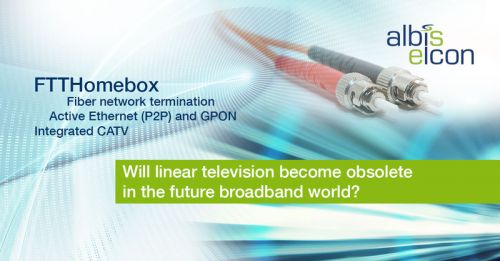
Over-the-top-content is today´s trend – more and more people, especially the young generation, use new service offers like YouTube or Netflix, to watch their favourite content. This development leads to increased bandwidth demands and is a huge challenge for network operators, whose traditional linear television offers are called into question. What will future solutions look like? Questions around this topic, are answered by Eric van den Heuvel, Vice President for Product Unit Infrastructure at albis-elcon.
Do you regularly watch TV in the evening?
Very seldom! Since I am travelling quite a lot, I prefer using Video-on-Demand services. But every now and then, on occasion, I switch on the TV to watch one or another match of the current European football championship.
So you are a trend-follower. Unfortunately, this is a huge challenge for network operators. How can they react to meet the growing bandwidth demand and respond to the changing viewing behaviour of today´s TV consumers?
What we can see these days, is not a one-off phenomenon, but a continuous process. Streaming in UHD-1-(4k)-resolution will soon be followed by UHD-2-(8k) and 3D. Where today 15-MP-photos are uploaded into the cloud, in future it will be 50-MP-photos. Data volumes are growing exponentially. Therefore it needs solutions that are not too short-sighted. In the long run, many technological approaches will not be able to keep the pace of future developments. From today´s point of view, only fiber cable deployment can provide almost unrestricted bandwidth for the future.
What does that mean for the network operators?
For all network operators it means that there is either short or mid-term focus on fiber access. Data transfer via fiber is symmetric with a bidirectional throughput of currently up to 1 Gbit/s. In the future higher bandwidths are foreseeable. The TV signal can be provided on the same fiber via RF overlay, without an additional TV cable network. The fiber approach enables the network operator to satisfy the classic broadcast zappers and to provide the performance for fastidious video-on-demand-service, both completely independent of one another.
Does albis-elcon have a concrete hardware solution?
Specifically for this application we developed the FTTHomebox. It is designed for physical network rollouts (layer 1) and can terminate any FTTH network type – Active Ethernet (P2P) and GPON – with up to four fiber connections. Moreover, the FTTHomebox features an integrated CATV receiver. We rely on the RF overlay solution, which transmits the broadcast signals to the customers via an additional wavelength in the fiber.
What are the advantages of the FTTHomebox for the network operators?
The certainty, that the network is absolutely future-proof. The network operators can reliably calculate the costs for the network rollout on a long-term basis and fall back on open access business models.




